Common fish that start with the letter P include Pacific Fat Sleeper Goby, Pacific Cod, Pacific Hake, Pacific Herring, Pacific Lamprey, Panda Catfish (Panda Corydoras), Parrot Cichlid, Peacock Cichlid, Peter’s Elepantnose Fish, Pink Salmon, Polly Marbled Bichir, Pufferfish, Pike, Permit Fish, and Piranha Fish. Read on to learn more about these amazing fruits!
Have you ever thought about how many different types of fish there are in the world? From the tiniest guppies to the massive blue whale, the variety of aquatic life is truly astounding. But today, we’re focusing on a specific question – how many species of fish have a common name that starts with the letter P? It may seem like a minor detail, but you’d be surprised by how many fish fall into this category. So, let’s dive in and explore the fascinating world of fish names, starting with the letter P!
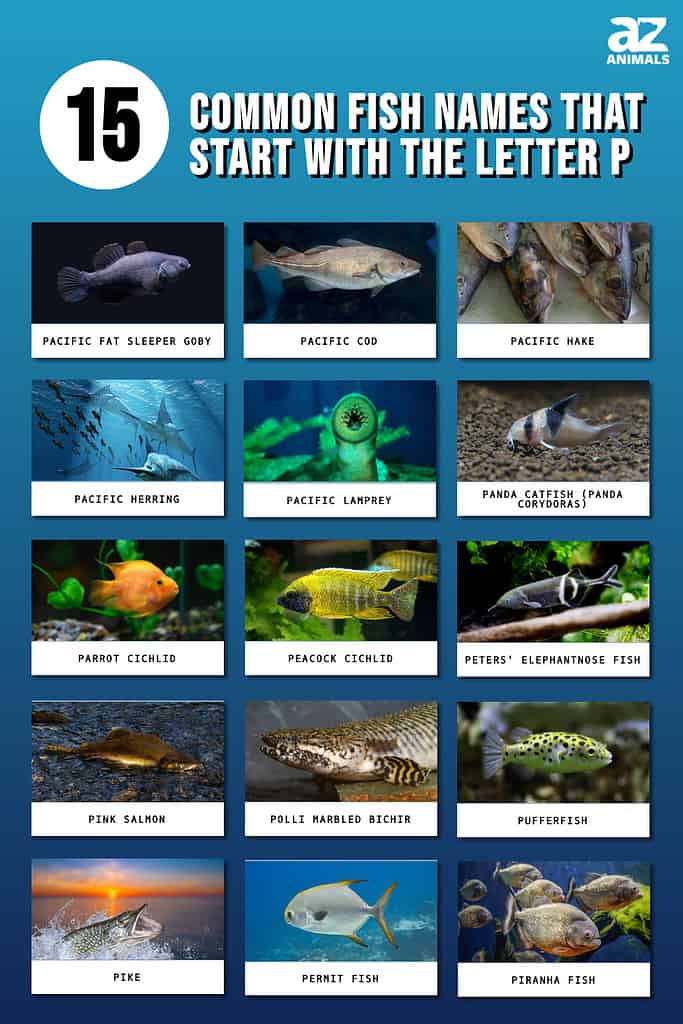
15 Common Fish Names That Start With The Letter P:
1. Pacific Fat Sleeper Goby

Pacific Fat Sleeper Goby
©Mathee Suwannarak/Shutterstock.com
The Pacific Fat Sleeper Goby, also known as Dormitator latifrons, is a species of fish in the family Eleotridae. This fish is found on the west coast of the United States, from California to Peru, in stagnant or sluggish fresh or brackish waters. It is a bottom dweller and a carnivorous predator, feeding on a variety of small fish, crustaceans, and insects.
The Pacific Fat Sleeper Goby can grow up to approximately 40cm in length, and it is an important species to local commercial fisheries. In terms of aquarium care, these fish need a lot of space and high-quality water conditions. They are also difficult to see visually.
2. Pacific Cod
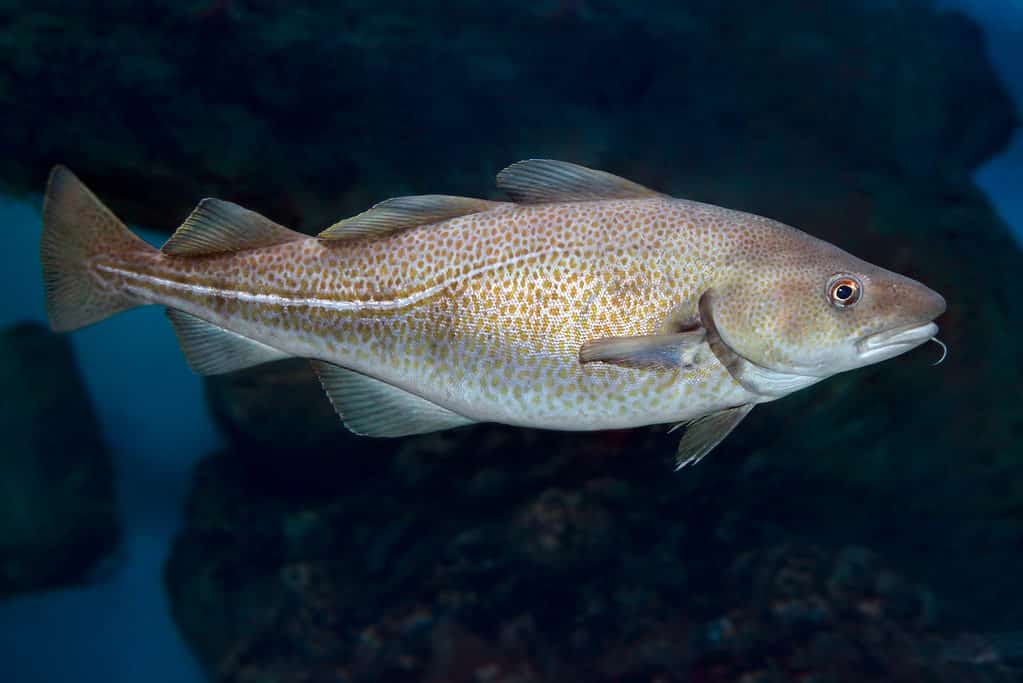
Pacific Cod
©iStock.com/TatianaMironenko
Pacific Cod, also known as Gadus macrocephalus, is a species of saltwater fish that is part of the cod family Gadidae. It is found in the North Pacific, ranging from the Sea of Japan to Alaska and beyond. Pacific Cod inhabit areas of sandy or muddy sea bottoms and often live in large schools.
As a food fish, Pacific Cod is popular for its mild, flaky white flesh, which is often used in fish and chips and other dishes. The fish can grow up to about a meter in length and can be a significant part of commercial fisheries in the region. The population status of Pacific Cod is currently unknown, but efforts are being made to monitor and manage sustainable harvest levels.
3. Pacific Hake

Pacific Hake
©Klopping/Shutterstock.com
Pacific hake, also known as Pacific whiting, is a species of fish that belongs to the Merlucciidae family. It is found along the west coast of North America, from Alaska to California, and is an important commercial species. Pacific hake has a slender, elongated body and can reach up to 3 feet in length, although most are around 18-24 inches long. They typically live in mid-water depths and feed on small fish, squid, and plankton.
In terms of culinary value, Pacific hake is a popular choice due to its mild, delicate flavor and firm, flaky texture. It is commonly used for fish and chips, fish tacos, and other seafood dishes.
4. Pacific Herring
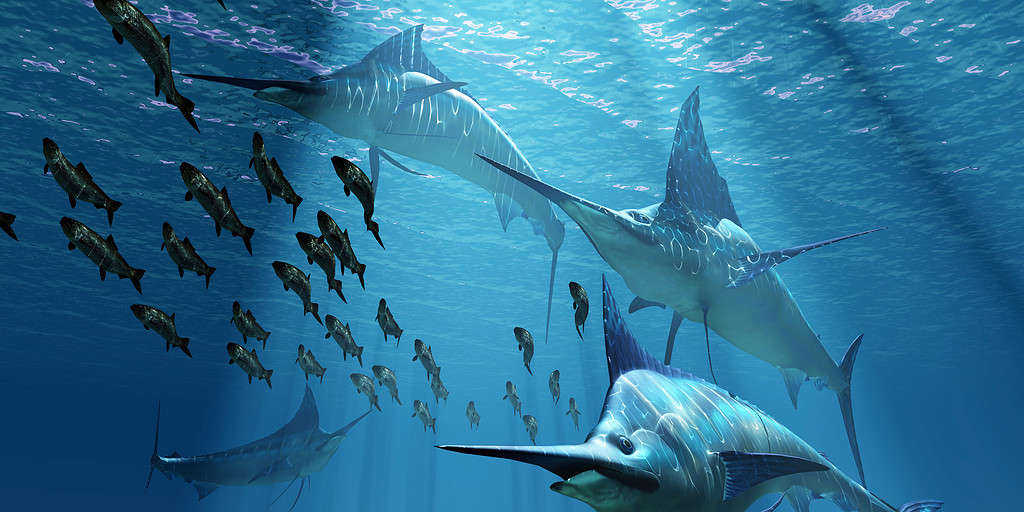
A pack of Indo-Pacific Blue Marlin predatory fish hunt a school of Pacific Herring fish.
©iStock.com/CoreyFord
Pacific herring is a species of fish found in the Pacific Ocean along the western coast of North America and northeast Asia. They are coastal schooling fish and grow to be approximately 15 inches long. Pacific herring have a blue-green upper body with silvery sides and no markings. They are laterally compressed, and their scales along the underside of their bodies project.
Pacific herring serves as an important foundation for marine ecosystems and supports commercial fishing industries. The Pacific Herring is often used for food, as it has a rich flavor and delicate texture.
5. Pacific Lamprey

Pacific Lamprey
©Avdey/Shutterstock.com
The Pacific lamprey is a parasitic fish native to the Pacific Coast of North America and Asia. The scientific name for Pacific lamprey is Entosphenus tridentatus. They are eel-like fish that use both freshwater and marine habitats to complete their life cycle. Pacific lamprey has a slender body and can grow up to 30 inches long, and they are dark blue or brown in color. They lack jaws and instead have a mouth that they use to attach to host fish in order to feed on their blood and tissues.
Despite their parasitic lifestyle, Pacific lamprey is a culturally significant species for many Native American tribes in the Pacific Northwest. They play an important role in the ecosystem as a food source for birds, mammals, and other fish species.
6. Panda Catfish (Panda corydoras)
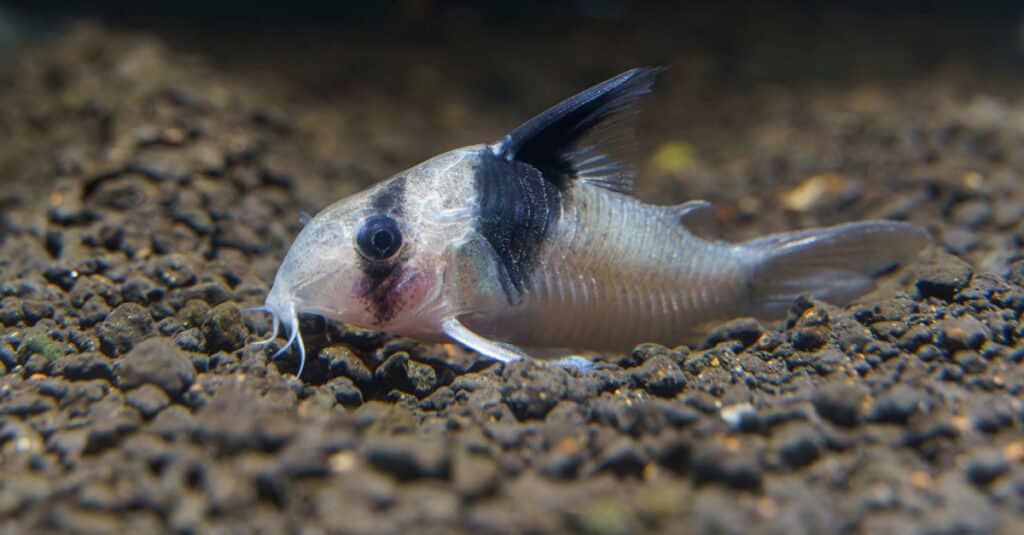
Panda Catfish (
Panda corydoras) are peaceful and social, making them a good addition to smaller freshwater aquariums.
©chonlasub woravichan/Shutterstock.com
Panda Corydoras, also known as Panda Catfish, is a species of freshwater fish belonging to the genus Corydoras in the family Callichthyidae. They are native to the upper Amazon Basin in Peru and are a popular choice in the aquarium hobby due to their attractive black-and-white coloration. These fish are peaceful and social, making them a good addition to smaller freshwater aquariums. They have a maximum size of about 2 inches (5 cm) and require a well-established aquarium with plenty of hiding places, as well as a sand or fine-gravel substrate.
In terms of diet, Panda Corydoras is omnivorous and will accept a wide range of foods, including sinking pellets, frozen or live foods, and algae wafers. They are also known for their “armored” bodies, which are covered in sharp, bony plates that protect them from predators.
7. Parrot Cichlid
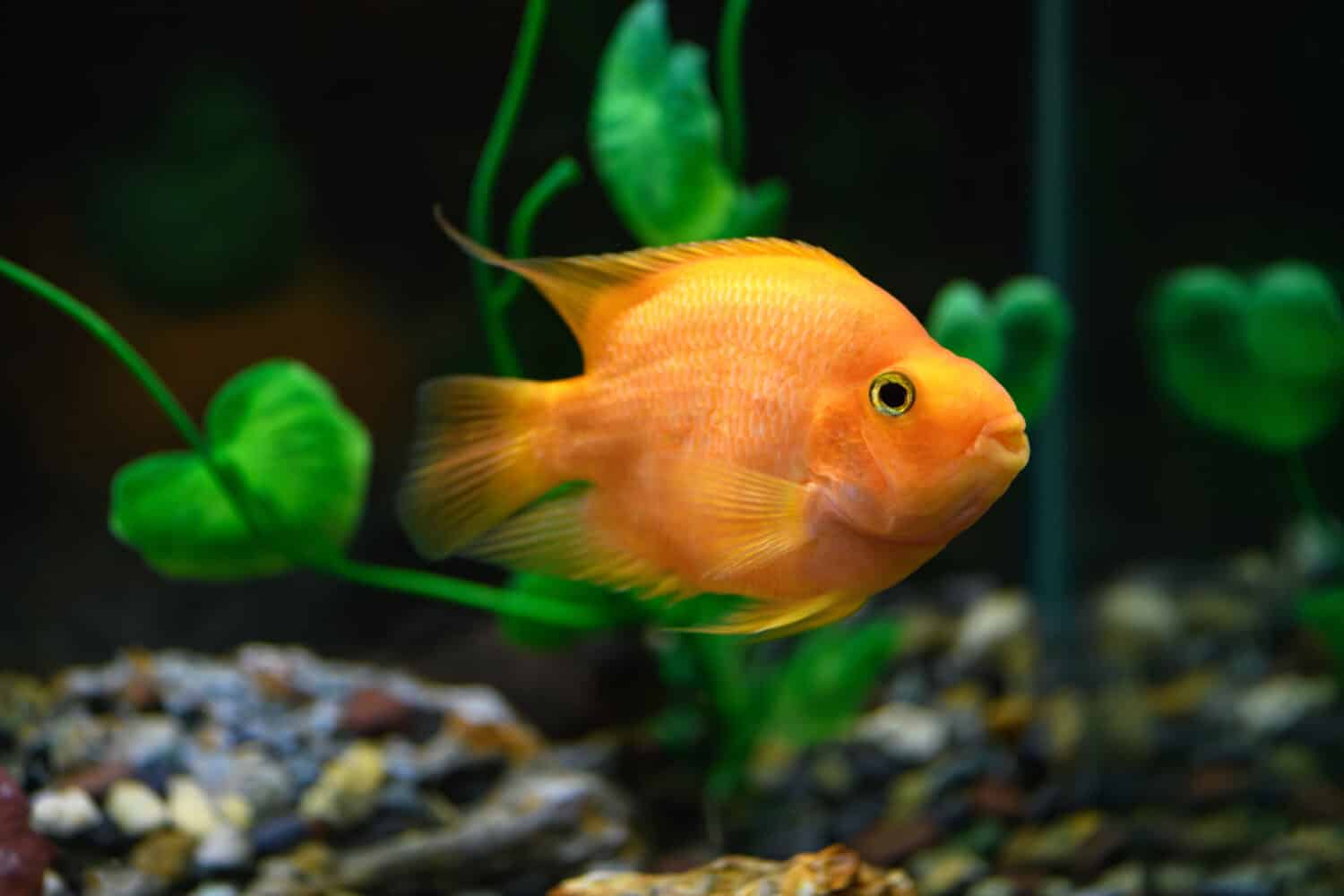
It is believed that the Red Parrot Cichlid is a hybrid of the Midas cichlid and the redhead cichlid.
©Bk87/Shutterstock.com
The parrot cichlid, also known as the blood parrot cichlid, is a hybrid species of freshwater fish that was first developed in Taiwan in the 1980s. The exact genetic origins of the parrot cichlid are not entirely clear, but it is believed to be a hybrid of the Midas cichlid and the redhead cichlid. The parrot cichlid is known for its bright coloration, which can range from bright orange to deep red and even include a mottled or speckled pattern. The species has a rounded, inwardly curved mouth which is the result of a genetic mutation that causes the jaw to form differently than other fish.
Due to this deformity, the parrot cichlid can be more difficult to feed and care for than other fish, and their use as pets is somewhat controversial in the aquarium hobby. Despite this, they are still a popular species due to their unique appearance and interesting behavior. The parrot cichlid is also known by other names, such as the jelly bean parrot or simply the parrot fish.
8. Peacock Cichlid

Yellow Peacock cichlids are popular in the aquarium hobby due to their beautiful and vibrant colors, with males displaying brighter colors than females.
©Arunee Rodloy/Shutterstock.com
The Peacock Cichlid is a species of freshwater fish that belongs to the genus Aulonocara, found in Lake Malawi, Africa. They are popular in the aquarium hobby due to their beautiful and vibrant colors, with males displaying brighter colors than females. Peacock Cichlids are relatively peaceful and can be kept with other African cichlids of similar size and temperament. They are omnivorous and will accept a wide range of foods, including flakes, pellets, frozen, or live foods.
In the wild, they feed primarily on small crustaceans, such as shrimp and plankton. To care for Peacock Cichlids, it is recommended to maintain a pH between 7.5 and 8.5 and a temperature range of 75-82°F. They require a well-filtered aquarium with plenty of caves and hiding places to establish territories and spawning sites. Peacock Cichlids are popular due to their unique colors and personalities, making them a colorful and dynamic addition to any freshwater aquarium.
9. Peters’ Elephantnose Fish

Peters’ Elephantnose Fish are capable of generating weak electrical pulses themselves for communication and navigation.
©boban_nz/Shutterstock.com
Peters’ Elephantnose Fish, also known as Gnathonemus petersii, is a freshwater fish belonging to the Mormyridae family, native to the rivers and lakes of Central and West Africa. They are known for their unique elongated and flattened snout, which they use to detect prey using electrical fields. They are also capable of generating weak electrical pulses themselves for communication and navigation.
Peters’ Elephantnose Fish are nocturnal and peaceful, requiring a well-filtered aquarium with plenty of hiding places and a fine substrate. They are omnivorous and will accept a variety of foods, including flakes, pellets, and frozen or live foods. They are an interesting and unique species for aquarium enthusiasts who are interested in keeping exotic fish.
10. Pink Salmon
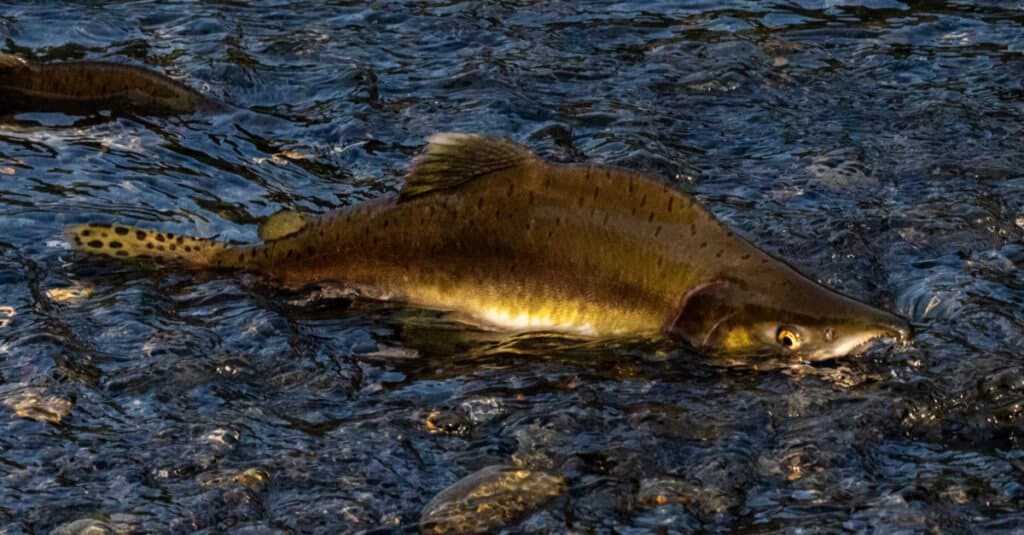
Pink Salmon are an important food source for humans and other animals.
©Mark A. McCaffrey/Shutterstock.com
Pink Salmon, also known as Humpback Salmon, is a species of salmon native to the Pacific Ocean, ranging from Japan and Russia to the western coast of North America. They are the smallest and most abundant of the Pacific salmon species, with an average weight of 3 to 5 pounds (1.4 to 2.3 kg). When they are spawning, male Pink Salmon develop a humpback appearance and a dark color on their back and fins.
They are an important food source for humans and other animals, and commercial and sport fishing for Pink Salmon is popular in many areas. In the United States, Alaska is the largest producer of Pink Salmon, with a significant portion of the catch going towards canning and smoking. Pink Salmon is also consumed fresh and frozen and is often used in sushi and sashimi dishes.
11. Polli Marbled Bichir
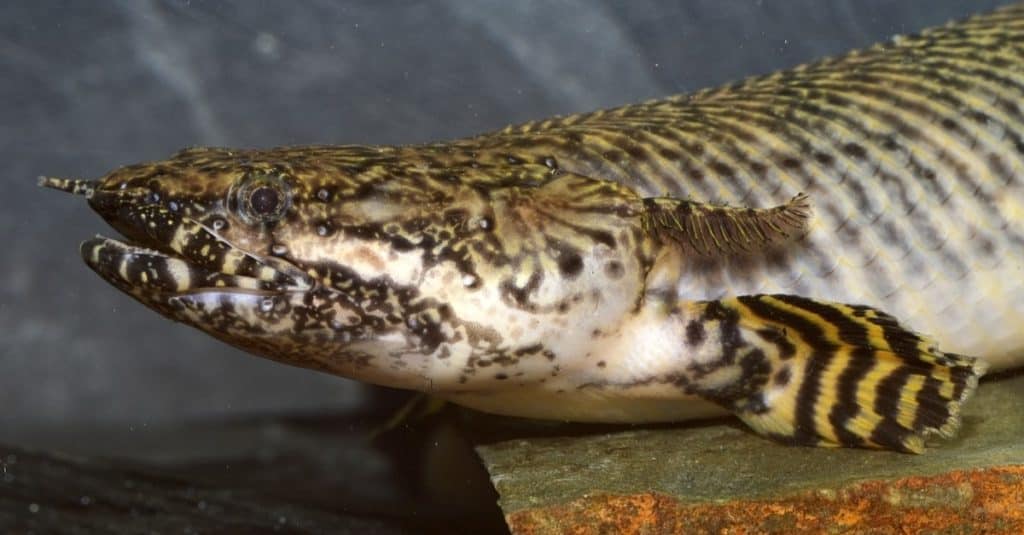
Bichirs can live 15-20 years and are a popular choice in the aquarium hobby due to their interesting appearance and unique behavior.
©Guillermo Guerao Serra/Shutterstock.com
Polli Marbled Bichir is a species of freshwater fish belonging to the genus Polypterus in the family Polypteridae. They are native to Central Africa and are commonly found in slow-moving waters. They have a unique, elongated body shape with a series of dorsal fins, and are known for their ability to breathe air. Polli Marbled Bichir is a predatory species that feeds on a variety of prey, including small fish, crustaceans, and insects. They are a popular choice in the aquarium hobby due to their interesting appearance and unique behavior.
Polli Marbled Bichir requires a well-established freshwater aquarium with a soft substrate and plenty of hiding places. They are hardy fish that can tolerate a range of water conditions, but larger tanks are recommended for adult specimens. It is important to note that Bichirs have a large adult size and can be quite long-lived, so they require careful consideration before being kept as pets.
12. Pufferfish
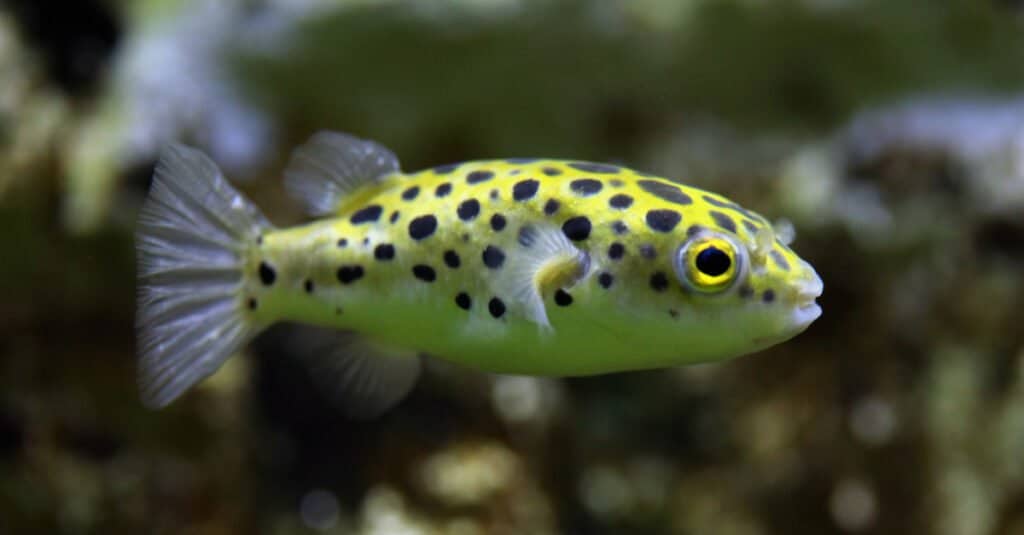
Freshwater Green
Pufferfish
are known for their ability to produce tetrodotoxin, a potent neurotoxin that can be lethal to humans if ingested.
©Vladimir Wrangel/Shutterstock.com
Pufferfish, also known as blowfish, are a group of fish that are known for their unique ability to inflate their bodies into a sphere-like shape in order to evade predators. They are found in both freshwater and saltwater environments and can be found in tropical and subtropical regions around the world. Pufferfish have tough skin and spines on their exterior, making them difficult to swallow.
They are also known for their ability to produce tetrodotoxin, a potent neurotoxin that can be lethal to humans if ingested. Despite this, pufferfish are considered a delicacy in many parts of the world, particularly in Japan where fugu is served in high-end restaurants. However, preparing pufferfish is an extremely delicate process, as the organs containing the toxin must be removed with great care to avoid contamination. Pufferfish are a fascinating and unique group of fish that continue to captivate fish enthusiasts around the world.
13. Pike
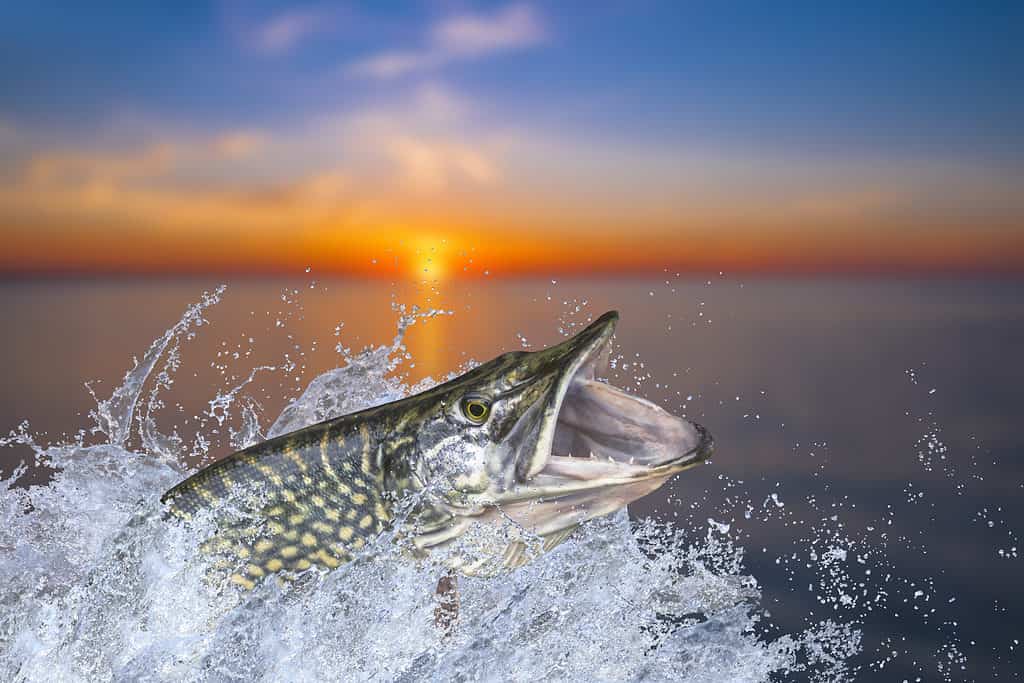
Pike Fish (Northern Pike) are known for their long, toothy jaws and torpedo-shaped bodies, and can grow up to several feet in length.
©iStock.com/FedBul
Pike, also known as Northern Pike, is a popular game fish that is found in freshwater lakes and rivers throughout the Northern Hemisphere, including North America, Europe, and Asia. They are known for their long, toothy jaws and torpedo-shaped bodies, and can grow up to several feet in length. Northern Pike are predatory fish that feed on a variety of prey, including fish, frogs, and small mammals. They are also popular among anglers for their fighting ability and are considered a prized catch.
Northern Pike is typically caught using a variety of lures, including spoons, crankbaits, and live bait such as minnows or leeches. They are also known for their firm, white flesh and are often used in cuisine. However, due to their tendency to accumulate toxins such as mercury, it is important to limit consumption of Northern Pike to small amounts and pay attention to fish advisories in your area.
14. Permit Fish

Permit Fish, Golden-yellow fins with big, black eyes are the most striking features of a permit.
©Ibrahim Shareef/Shutterstock.com
Permit Fish, also known as Trachinotus falcatus, is a popular game fish found in the western Atlantic Ocean, ranging from Massachusetts to Brazil. They are known for their silver or gray bodies, which are generally oval-shaped with a forked tail, a narrow head, and a single dorsal fin. Permit Fish are predatory and feed on a variety of prey, including crabs, shrimp, and small fish. They are popular among anglers for their fighting ability, which has earned them a reputation as one of the most challenging fish to catch on the flats.
Permit Fish is also considered a prized catch for their firm and sweet-tasting meat, which is often compared to that of Red Snapper or Pompano. There are also several different species of Permit, including the Palometa, the Bonefish, and the Triggerfish, among others, each with their unique characteristics and behaviors.
15. Piranha Fish

Piranhas are omnivorous and feed on a variety of prey, including fish, insects, and other aquatic animals.
©Jinny Jin/Shutterstock.com
Piranhas are a group of freshwater fish found in the Amazon basin and other rivers in South America. They are known for their sharp teeth and fierce reputation as predators, but they are not as dangerous to humans as many people believe. In fact, most species of piranha are actually quite shy and avoid human contact. Piranhas are omnivorous and feed on a variety of prey, including fish, insects, and other aquatic animals.
There are over 60 different species of piranha, each with its unique characteristics and behavior patterns. While they are not typically kept as pets due to their aggressive nature and specific care requirements, Piranhas are still fascinating creatures that have captured the imagination of people for generations.
In Conclusion
As you can see, fish that start with the letter P are incredibly diverse, ranging from popular game fish like the Northern Pike and Permit Fish to the infamous Piranha Fish found in South America. While they share a common beginning letter, each species has its unique characteristics, behaviors, and habitats, making them fascinating creatures to study and observe.
From freshwater to saltwater environments, and from docile herbivores to ferocious predators, the fish that start with P demonstrate the incredible diversity and complexity of aquatic life. Whether you are a fish enthusiast, an angler, or simply a lover of nature, the fish that start with P offers something for everyone to appreciate and enjoy!
Summary of Explore 15 Fish That Start With P (Common Names)
| Fish | |
|---|---|
| 1 | Pacific Fat Sleeper Goby |
| 2 | Pacific Cod |
| 3 | Pacific Hake |
| 4 | Pacific Herring |
| 5 | Pacific Lamprey |
| 6 | Panda Catfish |
| 7 | Parrot Cichlid |
| 8 | Peacock Cichlid |
| 9 | Peters’ Elephantnose Fish |
| 10 | Pink Salmon |
| 11 | Polli Marbled Bichir |
| 12 | Pufferfish |
| 13 | Pike |
| 14 | Permit Fish |
| 15 | Piranha Fish |
The photo featured at the top of this post is © Tatiana Belova/Shutterstock.com
Thank you for reading! Have some feedback for us? Contact the AZ Animals editorial team.






